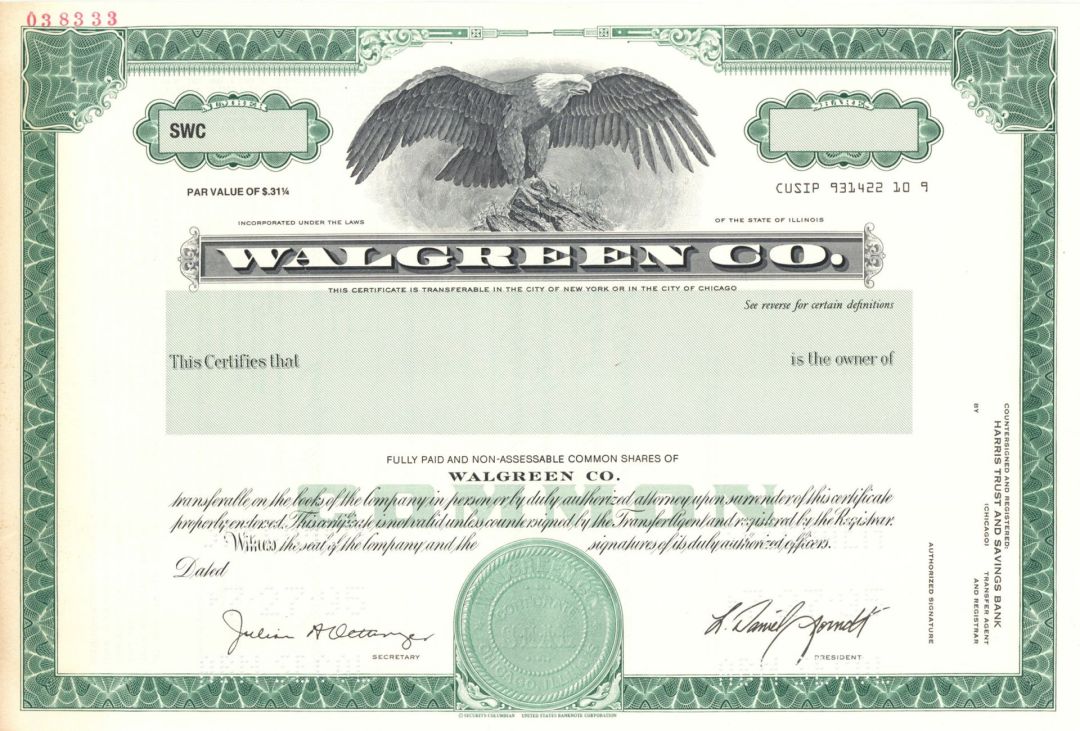Walgreen Co. - 1995 dated Specimen Stock Certificate
Inv# SE1222 Specimen StockNew York
Specimen Stock printed by Security-Columbian United States Banknote Corporation. Some staining in left border. Walgreens is an American company that operates the second-largest pharmacy store chain in the United States, behind CVS Health. It specializes in filling prescriptions, health and wellness products, health information, and photo services. It was founded in Chicago in 1901, and is headquartered in the Chicago suburb of Deerfield, Illinois. On December 31, 2014, Walgreens and Switzerland-based Alliance Boots merged to form a new holding company, Walgreens Boots Alliance. Walgreens became a subsidiary of the new company, which retained its Deerfield headquarters and trades on the Nasdaq under the symbol WBA. In 2021 the company was found by a federal jury to have "substantially contributed to" the opioid crisis. The company was founded as the Walgreen Drug Co., and did business under that name from 1901 to 1931. It was known as Walgreen Drug Stores from 1931 to 1948, and Walgreen's from 1948 to 1955. In 1955 the apostrophe was dropped from the name on retail outlets, which began using the "Walgreens" name.
Walgreens began in 1901, with a small food front store on the corner of Bowen and Cottage Grove Avenues in Chicago, owned by Dixon, Illinois native Charles R. Walgreen. By 1913, Walgreens had grown to four stores on Chicago's South Side. It opened its fifth in 1915 and four more in 1916. By 1919, there were 20 stores in the chain. As a result of alcohol prohibition, the 1920s were a successful time for Walgreens. Although alcohol was illegal, Walgreens sold prescription whiskey. This prescribed alcohol was sold at inflated price, which was much higher than the pricing at the bathtub or the speakeasy. In 1922, the company introduced a malted milkshake, which led to its establishing ice cream manufacturing plants. A Walgreens employee called Ivar Coulson modified the basic malted milk recipe by adding scoops of vanilla ice cream. The milkshake was sold at $0.20 and Walgreens became the place to "hang out". The next year, Walgreens began opening stores away from residential areas. In the mid-1920s, there were 44 stores with annual sales of $1,200,000 combined. Walgreens had also expanded by then into Minnesota, Missouri, and Wisconsin. By 1930, it had 397 stores with annual sales of $4,000,000.
This expansion partly was attributed to selling prescribed alcohol, mainly whiskey, which Walgreen often stocked under the counter, as accounted in Daniel Okrent's Last Call: The Rise and Fall of Prohibition. The stock market crash in October 1929 and subsequent Great Depression did not greatly affect the company. By 1934, Walgreens was operating 601 stores in 30 states. After Walgreen died in 1939, his son Charles R. Walgreen Jr. took over the chain until his retirement. The Charles R. Walgreen Jr. years were relatively prosperous but lacked the massive expansion seen in the early part of the century. In 1946, Walgreens purchased Sanborns, one of Mexico's largest pharmacy and department store chains, from Frank Sanborn (Walgreens sold Sanborns to Grupo Carso in 1982). Charles "Cork" R. Walgreen III took over after Walgreen Jr.'s retirement in the early 1950s and modernized the company by switching to barcode scanning.
The company also created larger-sized Walgreens Superstores and purchased the Globe Discount City chain of big-box stores from United Mercantile, Inc. in the 1960s. The Walgreen family was not involved in senior management of the company for a short time after Walgreen III retired. In the 1980s Walgreens owned and operated a chain of casual family restaurants/pancake houses called Wag's. Walgreens sold most of these to Marriott Corp. in 1988, and by 1991 the chain was out of business. In 1986, Walgreens acquired the MediMart chain from Stop & Shop. Kevin P. Walgreen was made a vice-president in 1995 and promoted to senior vice president of store operations in 2006. Read more at https://en.wikipedia.org/wiki/Walgreens
Stock and Bond Specimens are made and usually retained by a printer as a record of the contract with a client, generally with manuscript contract notes such as the quantity printed. Specimens are sometimes produced for use by the printing company's sales team as examples of the firms products. These are usually marked "Specimen" and have no serial numbers.











Ebay ID: labarre_galleries